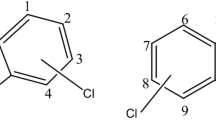Abstract
Polychlorinated aromatic compounds, including pentachlorobenzenes and hexachlorobenzenes, are recalcitrant industrial pollutants that cause adverse effects on living cells. In this paper, the isolation of Pseudomonas fluorescens species with high resistance to pentachlorobenzene (PeCB) is reported. It was found that, in contrast to its slightly negative effect on P. fluorescens growth, PeCB readily inhibited the cell growth of Serratia spp. and Escherichia coli strains, thus indicating that inhibition of bacterial growth by PeCB is species-dependent. Analysis of a P. fluorescens isolate revealed that the exposure to PeCB induced production of reactive oxygen species and led to an increase in the level of alkyl hydroperoxide reductase C (AhpC), an important enzyme enhancing the cell tolerance to organic hydroperoxides usually accumulated under oxidative stress. The putative mechanism conferring PeCB resistance to P. fluorescens and the potential use of P. fluorescens in bioremediation are discussed.





Similar content being viewed by others
References
Arora PK, Bae H (2014) Role of dehalogenases in aerobic bacterial degradation of chlorinated aromatic compounds. J Chem:157974. doi:10.1155/2014/157974
Atlas RM, Bartha R (1997) Physiological ecology of microorganisms: adaptations to environmental conditions. In: Ronald M, Bartha R (eds) Microbial ecology: fundamentals and applications. Benjamin Cummings Science Publishing, Menlo Park, California
Bennasar A, Mulet M, Lalucat J, Garcia-Valdes E (2010) PseudoMLSA: a database for multigenic sequence analysis of Pseudomonas species. BMC Microbiol 10:118. doi:10.1186/1471-2180-10-118
Chavarria M, Nikel PI, Perez-Pantoja D, de Lorenzo V (2013) The Entner-Doudoroff pathway empowers Pseudomonas putida KT2440 with a high tolerance to oxidative stress. Environ Microbiol 15:1772–1785. doi:10.1111/1462-2920.12069
Chen X et al (2002) Crystal structure of the F87W/Y96F/V247L mutant of cytochrome P-450cam with 1,3,5-trichlorobenzene bound and further protein engineering for the oxidation of pentachlorobenzene and hexachlorobenzene. J Biol Chem 277:37519–37526. doi:10.1074/jbc.M203762200
de Bont JA, Vorage MJ, Hartmans S, van den Tweel WJ (1986) Microbial degradation of 1,3-dichlorobenzene. Appl Environ Microbiol 52:677–680
Field JA, Sierra-Alvarez R (2008) Microbial degradation of chlorinated benzenes. Biodegradation 19:463–480. doi:10.1007/s10532-007-9155-1
Gregoraszczuk EL et al (2014) Hexachlorobenzene and pentachlorobenzene accumulation, metabolism and effect on steroid secretion and on CYP11A1 and CYP19 expression in cultured human placental tissue. Reprod Toxicol 43:102–110. doi:10.1016/j.reprotox.2013.12.004
Imlay JA (2013) The molecular mechanisms and physiological consequences of oxidative stress: lessons from a model bacterium. Nat Rev Microbiol 11:443–454. doi:10.1038/nrmicro3032
Ivanova IA, Kambarev S, Popova RA, Naumovska EG, Markoska KB, Dushkin CD (2010) Determination of Pseudomonas putida live cells with classic cultivation and staining with “Live/Dead Baclight Bacterial Viability Kit”. Biotechnology & Biotechnological Equipment 24:567–570. doi:10.1080/13102818.2010.10817898
Jacobson FS, Morgan RW, Christman MF, Ames BN (1989) An alkyl hydroperoxide reductase from Salmonella typhimurium involved in the defense of DNA against oxidative damage. Purification and properties. J Biol Chem 264:1488–1496
Joux F, Lebaron P (1997) Ecological implications of an improved direct viable count method for aquatic bacteria. Appl Environ Microbiol 63:3643–3647
Mao DP, Zhou Q, Chen CY, Quan ZX (2012) Coverage evaluation of universal bacterial primers using the metagenomic datasets. BMC Microbiol 12:66. doi:10.1186/1471-2180-12-66
Matthiesen R, Trelle MB, Hojrup P, Bunkenborg J, Jensen ON (2005) VEMS 3.0: algorithms and computational tools for tandem mass spectrometry based identification of post-translational modifications in proteins. J Proteome Res 4:2338–2347. doi:10.1021/pr050264q
Mochizuki S (1977) Photochemical dechlorination of PCBs. Chem Eng Sci 32:1205–1210
Mohammad SM, Dennis GP (1997) Electrochemical reduction of di-, tri- and tetrahalobenzenes at carbon cathodes in dimethylformamide. Evidence for a halogen dance during the electrolysis of 1,2,4,5-tetrabromobenzene. J Electroanal Chem 435:47–53
Neilson AH (1996) An environmental perspective on the biodegradation of organochlorine xenobiotics. Int Biodeter Biodeg 37:3–21
Netuschil L, Auschill TM, Sculean A, Arweiler NB (2014) Confusion over live/dead stainings for the detection of vital microorganisms in oral biofilms—which stain is suitable? BMC Oral Health 14:2. doi:10.1186/1472-6831-14-2
Oldenhuis R, Kuijk L, Lammers A, Janssen DB, Witholt B (1989) Degradation of chlorinated and non-chlorinated aromatic solvents in soil suspensions by pure bacterial cultures. Appl Microbiol Biotechnol 30:211–217
Oliver BG, Nicol KD (1982) Chlorobenzenes in sediments, water, and selected fish from Lakes Superior, Huron, Erie, and Ontario. Environ Sci Technol 16:532–536
Poole LB, Ellis HR (1996) Flavin-dependent alkyl hydroperoxide reductase from Salmonella typhimurium. 1. Purification and enzymatic activities of overexpressed AhpF and AhpC proteins. Biochemistry 35:56–64. doi:10.1021/bi951887s
Robinson PE, Mack GA, Remmers J, Levy R, Mohadjer L (1990) Trends of PCB, hexachlorobenzene, and beta-benzene hexachloride levels in the adipose tissue of the U.S. population. Environ Res 53:175–192
Seaver LC, Imlay JA (2001) Alkyl hydroperoxide reductase is the primary scavenger of endogenous hydrogen peroxide in Escherichia coli. J Bacteriol 183:7173–7181
Singh S, Kang SH, Mulchandani A, Chen W (2008) Bioremediation: environmental clean-up through pathway engineering. Curr Opin Biotechnol 19:437–444. doi:10.1016/j.copbio.2008.07.012
Tartaglia LA, Storz G, Brodsky MH, Lai A, Ames BN (1990) Alkyl hydroperoxide reductase from Salmonella typhimurium. Sequence and homology to thioredoxin reductase and other flavoprotein disulfide oxidoreductases. J Biol Chem 265:10535–10540
Thomas RS, Gustafson DL, Pott WA, Long ME, Benjamin SA, Yang RS (1998) Evidence for hepatocarcinogenic activity of pentachlorobenzene with intralobular variation in foci incidence. Carcinogenesis 19:1855–1862
Winn LM (2003) Homologous recombination initiated by benzene metabolites: a potential role of oxidative stress. Toxicol Sci 72:143–149
Acknowledgements
We are grateful to the staff of the Genomics and Proteomics Units at the Advanced Core Research Facilities (SGIker) of the University of the Basque Country (UPV/EHU) for the technical support and assistance provided. The work was supported by the Basque Government (grant PRE-2013-1-901 and SAIOTEK grant S-PE12UN84) and by IKERBASQUE (Basque Foundation for Science).
Author information
Authors and Affiliations
Corresponding author
Ethics declarations
Conflict of interest
The authors declare that they have no conflict of interest.
Rights and permissions
About this article
Cite this article
Montánchez, I., Kaberdina, A.C., Sevillano, E. et al. Isolation of Pseudomonas fluorescens species highly resistant to pentachlorobenzene. Folia Microbiol 62, 325–334 (2017). https://doi.org/10.1007/s12223-017-0501-3
Received:
Accepted:
Published:
Issue Date:
DOI: https://doi.org/10.1007/s12223-017-0501-3




